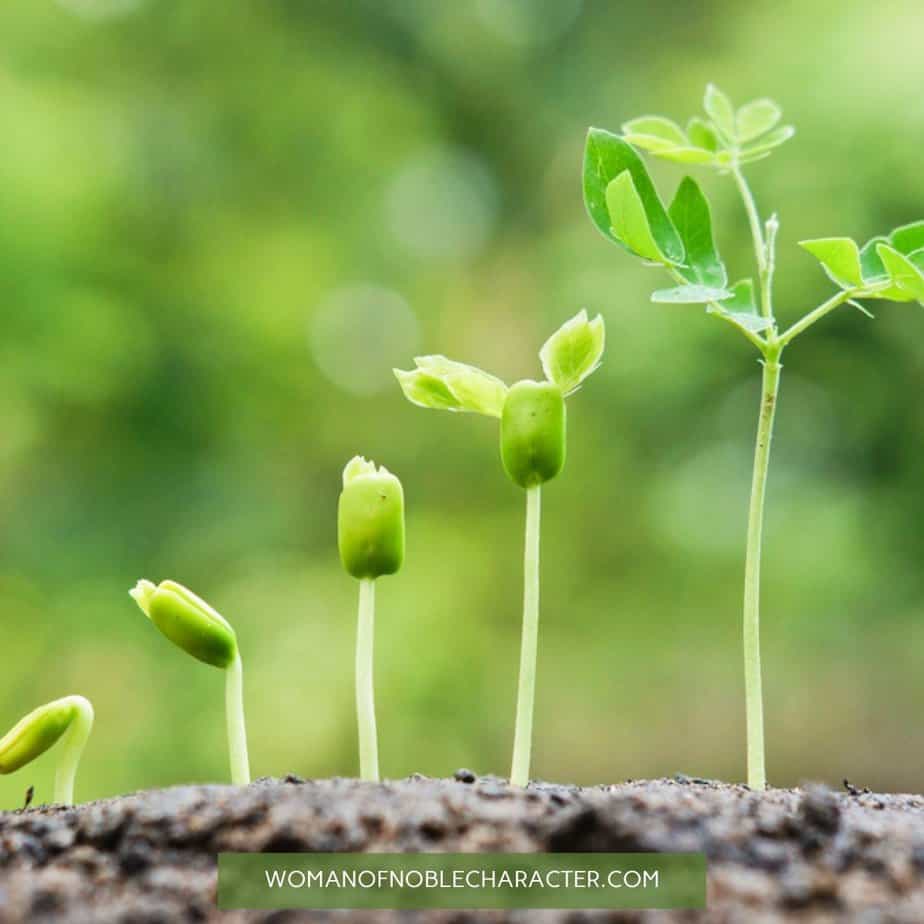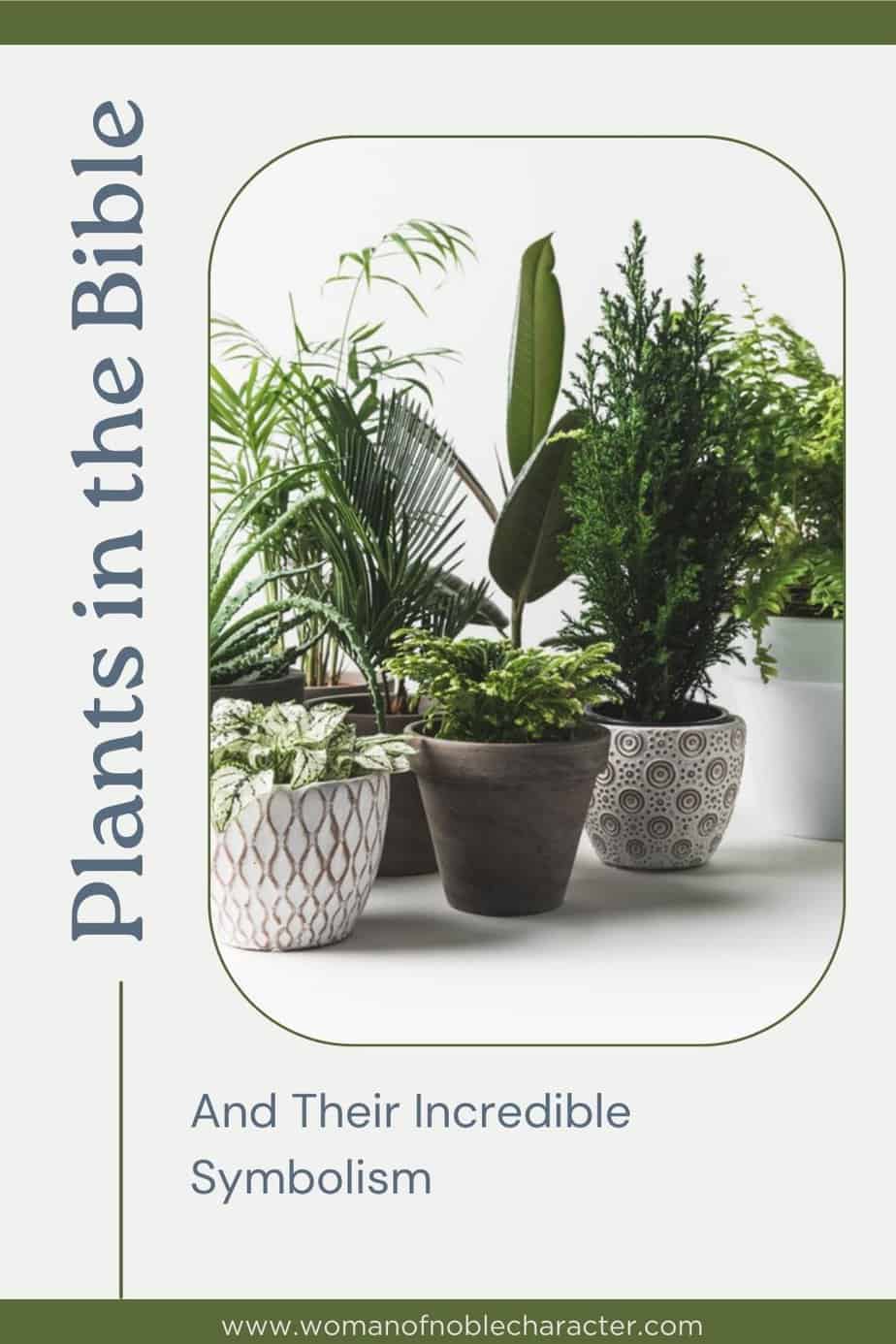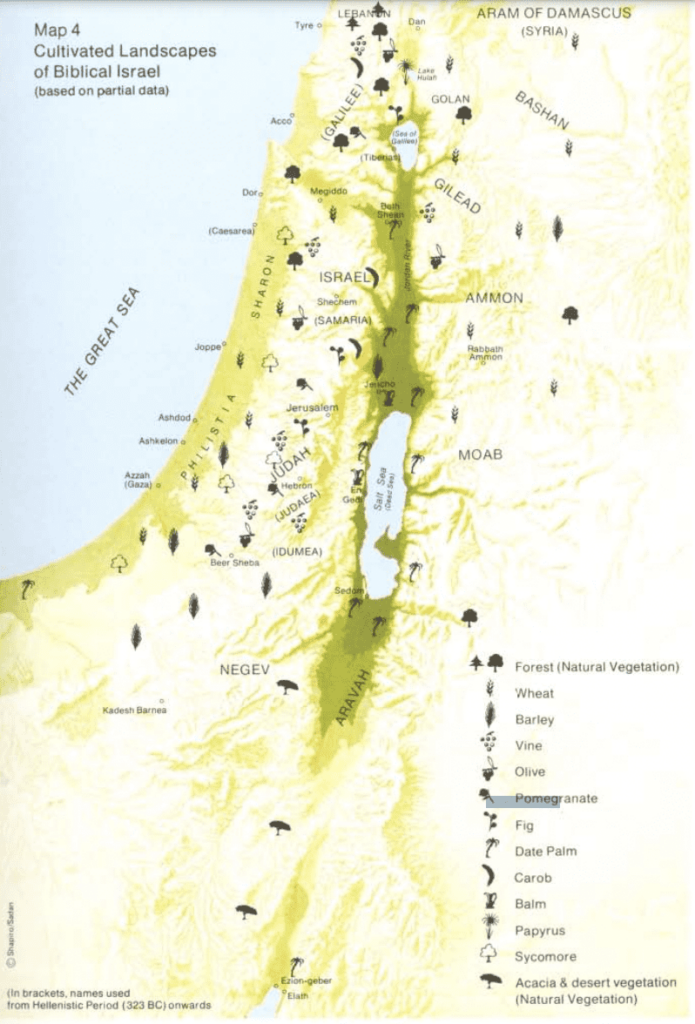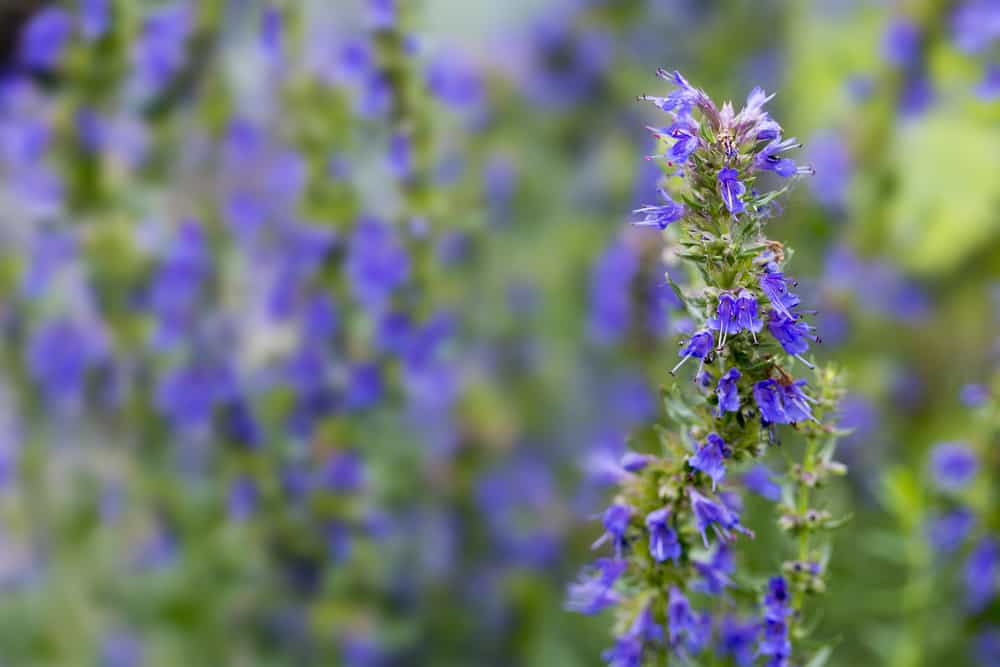The Incredibly Interesting Symbolism Of Plants In The Bible

I just love Bible symbolism. I enjoy learning more about the Bible through signs and symbols of most everyday things. In the past, I’ve written about birds in the Bible, specifically. Currently, I am writing two monthly features on color symbolism in the Bible and the names of God.
You may also enjoy learning about the essential oils of the Bible.
Recently, our pastor mentioned palms and almonds in the Bible, and, of course, it piqued my interest, and I had to know more. So, armed with boatloads of reading and researching, I decided to share some of my findings with you.

Plants in the Bible
Plants and flowers are mentioned throughout the Bible — from the “apples” of Genesis and the “bitter herbs” of Passover to the New Testament’s “lilies of the field.
The Incredibly Interesting Symbolism Of Plants In The Bible
The Incredibly Interesting Symbolism Of Plants In The BiblePlay Video
In scripture, plants often serve as illustrations for teaching spiritual truths.
Even modern-day plants are written about or named throughout the Bible, including in the Old Testament.
Let’s get “in the dirt” and “dig” into the symbolism of plants in the Bible to learn or get to the “root” of (see what I did there hahaha) their meaning and how it applies to our lives.
Let’s start with a bit of botany. What do plants need to survive? They need water, sun, and food of some sort (depending on the type of plant). Sound familiar? Humans need those things, too.
Both plants and humans thrive when under the care of a Master Gardener. (Do you see where I’m going here? :D)
Hosea compares plant growth to spiritual growth. in Hosea 14:5-7, we read:
I will be like the dew to Israel;
HOSEA 14:5-7 (ESV)
he shall blossom like the lily;
he shall take root like the trees of Lebanon;
his shoots shall spread out;
his beauty shall be like the olive,
and his fragrance like Lebanon.
They shall return and dwell beneath my shadow;
they shall flourish like the grain;
they shall blossom like the vine;
their fame shall be like the wine of Lebanon.
Here, he compares walking in obedience to the Lord to:
- the glory of a lily
- the fragrance of the cedars of Lebanon
- the beauty of an olive tree
- the fruit-bearing of a grapevine.
And Moses mentions plants and their byproducts to describe the abundance they would find in the promised land.
For the Lord your God is bringing you into a good land, a land of brooks of water, of fountains and springs, flowing out in the valleys and hills,a land of wheat and barley, of vines and fig trees and pomegranates, a land of olive trees and honey,
DEUTERONOMY 8:7-8 (ESV)
He didn’t point out a market on every corner or safety from enemies. Nope, he illustrated the abundance of plants and food.
Water, Water Everywhere
Water (one of those three important things that both plants and humans need) is illustrated throughout the Bible to demonstrate God’s pleasure or displeasure with His people.
Without water, plants will wither and die. Without the Living Water, humans will, as well.
Jesus said to her, “Everyone who drinks of this water will be thirsty again,but whoever drinks of the water that I will give him will never be thirsty again The water that I will give him will become in him a spring of water welling up to eternal life.”
JOHN 4:13-14 (ESV)
He is like a tree planted by water,
JEREMIAH 17:8 (ESV)
that sends out its roots by the stream,
and does not fear when heat comes,
for its leaves remain green,
and is not anxious in the year of drought,
for it does not cease to bear fruit.”
Sun, Sun, Mr. Golden Sun
In addition to water, plants (and humans) need sunlight to thrive. In Job 8:16, we read:
He is a lush plant before the sun,
JOB 8:16 (ESV)
and his shoots spread over his garden.
While we need actual sunshine to thrive and produce vitamin D in our bodies, we also need THE Son to shine and reign in our lives.
Let’s Look at some (there are hundreds) Plants in the Bible and their Significance:
Almonds/Almond Tree
Amygdalus communis or Prunus dulcis
The almond is a medium-sized tree with narrow, light green leaves.
The almond is well-known in the study of the symbolism of plants in the Bible. This is because it represents resurrection as it is the first tree to flower.
Within just a month after flowering, peculiar hairy green fruits begin to develop.
Almonds are mentioned six times in the Scriptures, but only in the Old Testament.
The first reference is in Genesis 43:11, where Jacob, in a sly attempt to gain favor with the ruler of Egypt, orders his sons to take some of the “best products of the land” including almonds. (I don’t know about you, but I love almonds and would love to receive one of the first original fruit and nut baskets!)
Then their father Israel said to them, “If it must be so, then do this: take some of the choice fruits of the land in your bags, and carry a present down to the man, a little balm and a little honey, gum, myrrh, pistachio nuts, and almonds.
GENESIS 43:11 (ESV)
Probably the best-known reference to the almond in the Bible is Aaron’s rod that budded and produced almonds overnight. (Numbers 17). Although the almond tree is a fast fruit producer (a month after flowering, as mentioned above), growing almonds overnight was miraculous.
I particularly love the reference to almonds in Ecclesiastes 12:5
they are afraid also of what is high, and terrors are in the way; the almond tree blossoms, the grasshopper drags itself along, and desire fails, because man is going to his eternal home, and the mourners go about the streets—
ECCLESIASTES 12:5 (ESV)
While Bible scholars disagree on the meaning of this verse, it appears to be a poem on aging and the fear of aging. You can read more about the meaning of Ecclesiastes 12:5 here and here.
The last reference in the Bible to the almond is in Jeremiah 1:11.
And the word of the Lord came to me, saying, “Jeremiah, what do you see?” And I said, “I see an almondbranch.”
JEREMIAH 1:11 (ESV)
God showed a rod of almond to the young Jeremiah; by changing just one letter in this word, it came out meaning “I watch over my words and perform them.” This shows how vital His promise is – he’ll ensure His Word is fulfilled.
Another fascinating thing to point out is that the Hebrew word for almond is shakeid (שָׁקֵד) or shaked, which means “wakeful, hastening,” – just as the almond tree hastens to flower.
We also see a motif of the almond motif as part of the design for the lampstand in the tabernacle found in Exodus.

three cups made like almond blossoms, each with calyx and flower, on one branch, and three cups made like almond blossoms, each with calyx and flower, on the other branch—so for the six branches going out of the lampstand.And on the lampstand itself there shall be four cups made like almond blossoms, with their calyxes and flowers,EXODUS 25:33-34 (ESV)
- The almond and hazel are also mentioned in an interesting story about Jacob tending Laban’s flocks. (Genesis 30)
- A piece of almond was Aaron’s rod that budded.
Cedar
cedrus
The cedar of Lebanon is referred to throughout the Bible, including references in 1 Kings, Ezekiel, Amos, Psalms, Jeremiah, and several other books of the Bible.
his shoots shall spread out;
HOSEA 14:6 (ESV)
his beauty shall be like the olive,
and his fragrance like Lebanon.
Just like the cedar tree, as believers in Christ, we should be strong and beautiful in our character. And just as cedar balls or chips are placed in closets to make clothes smell good, we should positively influence wherever we go—making that place “smell good” because of the Holy Spirit in our lives.
The voice of the Lord breaks the cedars;
PSALM 29:5 (ESV)
the Lord breaks the cedars of Lebanon.
Usitatissimum means “most useful,” which is an apt description of one of the Bible plants used for food and fiber.
Flax is planted in the winter in the Middle East and flowers in the late spring. Flax is one of the most beautiful crops when flowering, with beautiful light blue flowers that open only in the morning. It is often planted decoratively or ornamental.
Linen fabric is made from the cellulose fibers that grow inside the stalks of the flax plant.
Linen had more than a few uses in Biblical times. The most common was clothing.
But it was also used for making wicks, shrouds, ship sails, and measuring lines.
The man in Ezekiel 4 had linen (flax) measuring line. Our English word line is from the Latin word for flax. Words such as linear, lineage, etc., also come from the same root word.
The Scriptures are explicit in discussing the significance of linen when used as clothing. Fine linen represents the righteous acts of saints.
Put another way, it represents personal holiness and suggests that the person clothed in linen is in a condition suitable to approach God. One of the synonyms for a priest is one who “wears the linen ephod.”
Hyssop
Hyssopus officinalis
Hyssop is one of the most recognized plants in the Bible. It is referred to in ten places in the Old Testament, alone, and two in the New Testament.
This plant is an integral part of Passover (Exodus 12:22) and a ceremonial cleansing of the skin (Leviticus 14).
Hyssop also features prominently in the red heifer offering in Numbers 19.
My favorite verse regarding hyssop is found in Psalm 51:7.
Purge me with hyssop, and I shall be clean;
PSALM 51:7 (ESV)
wash me, and I shall be whiter than snow.

I often pray that God will wash me so I will be clean and whiter than snow. This speaks to the forgiveness that we have in Christ. Hyssop and its associated verses are excellent reminders of how we are washed clean by God’s forgiveness.
Surprisingly, hyssop is a member of the mint family.
According to the Scriptures, hyssop, ezov in Hebrew, must be grown in a particular way as it should grow on a “wall” according to I Kings 4:33.
Thus he shall cleanse the house with the blood of the bird and with the fresh water and with the live bird and with the cedarwood and hyssop and scarlet yarn.
LEVITICUS 14:52 (ESV)
Juniper
juniperus virginiana or juniperus drupacea
The Broom Tree is thought to be a juniper shrub that grows in Palestine. Mentioned in Psalm 120, this passage can be considered in several ways, including that the juniper was used to cleanse, purify and eliminate.
A warrior’s sharp arrows,
PSALM 120:4 (ESV)
with glowing coals of the broom tree!
This of the plants in the Bible is a dense, twiggy bush, almost leafless, which grew to about 12 feet tall. It has small white blooms.
Juniper, or The Broom Tree, is common in the desert regions of Palestine, Arabia, and Egypt. As mentioned in the above verse, it was used as charcoal.
It is also where the prophet Elijah rested and found shade.
But he himself went a day’s journey into the wilderness and came and sat down under a broom tree. And he asked that he might die, saying, “It is enough; now, O Lord, take away my life, for I am no better than my fathers.” And he lay down and slept under a broom tree. And behold, an angel touched him and said to him, “Arise and eat.”
1 KINGS 19:4-5 (ESV)
The Broom Tree roots were not edible, so those were not what Job ate. Instead, he may have eaten an edible parasite that infested the bush.
they pick saltwort and the leaves of bushes,
JOB 30:4 (ESV)
and the roots of the broom tree for their food.
Many biblical scholars believe the Juniper or The Broom Tree to be the shrub referred to in Jeremiah 17:6 and 48:6.
Lily of the Field (Anemone)
anemone coronaria
Wild field flowers in Palestine are almost certainly the anemones that Jesus referred to as “lilies of the field.” These beautiful, wild plants can still be found near Lake Galilee.
And why are you anxious about clothing? Consider the lilies of the field, how they grow: they neither toil nor spin,yet I tell you, even Solomon in all his glory was not arrayed like one of these. But if God so clothes the grass of the field, which today is alive and tomorrow is thrown into the oven, will he not much more clothe you, O you of little faith?
MATTHEW 6:28-30 (ESV)
The Anemone or poppy is one of the first flowers to appear in early spring. It only grows about a foot tall, but its bright colors make up for this deficiency with enthusiasm! These plants do not like wet feet and won’t tolerate freezing either.
They do produce an abundant amount of pollen due to their numerous stamens.
They secrete nectar and attract several insects, which feed on this sweet food.
Mustard
brassica juncea
Mustard has long been extensively cultivated and in biblical times and is the source of mustard-seed oil and medicine.
This plant can grow over six feet tall and is prevalent around the Sea of Galilee and farther north. Its seeds are tiny, just 0.039 of an inch!
The black mustard is a fascinating plant with large leaves that grow near the ground and cluster at their base.
The Greek “Sinapis” is believed to be ‘mustard.’ It’s not mentioned in the Old Testament but is often referred to in the Hebrew Mishnah.
And he said, “With what can we compare the kingdom of God, or what parable shall we use for it?It is like a grain of mustard seed, which, when sown on the ground, is the smallest of all the seeds on earth,yet when it is sown it grows up and becomes larger than all the garden plants and puts out large branches, so that the birds of the air can make nests in its shade.”
MARK 4:30-32 (ESV)
He put another parable before them, saying, “The kingdom of heaven is like a grain of mustard seed that a man took and sowed in his field.It is the smallest of all seeds, but when it has grown it is larger than all the garden plants and becomes a tree, so that the birds of the air come and make nests in its branches.”
MATTHEW 13:31-3 (ESV)
Myrtle
myrtus communis
The Hebrew and the Aramaic names for myrtle are hadas; the Arabic, as and rihan; the Accadian, asu. It is one of the four species the Israelites were ordered to use on the first day of Tabernacles.
The myrtle was popular with the biblical and post-biblical population of the Holy Land, and its name was given to men, Assa, and to women, Hadassah.
He was bringing up Hadassah, that is Esther, the daughter of his uncle, for she had neither father nor mother. The young woman had a beautiful figure and was lovely to look at, and when her father and her mother died, Mordecai took her as his own daughter.
ESTHER 2:7 (ESV)
Its lovely, aromatic branches had many uses.
The leaves of this tree are used in betrothal ceremonies and as remedies because they have oil-secreting glands within the palisade tissue.
The myrtle, significant in ritual and art throughout ancient Greece, was dedicated to Aphrodite.
The Feast of Tabernacles is a time when we remember the Israelites’ flight from Egypt and how they were able to survive in harsh conditions. Myrtle branches were used as roofing material for these outdoor booths, which would be temporary homes during this Hebrew festival.
The common myrtle is a plant that grows not only in damp plains like the banks of the Jordan River and Dan Valley.
The plant’s leaves are fragrant and shiny due to tiny oil glands. The summertime flowers are white, star-shaped, with edible olive-like fruit.
Myrtle is an evergreen shrub that can grow up to 6 and a half feet tall.
Myrtles are beautiful plants that grow wild on hillsides in both dry and moist soil. They will not survive a hard winter and produce abundant flowers when planted in full sun.
I will put in the wilderness the cedar,
— ISAIAH 41:19-20 (ESV)
the acacia, the myrtle, and the olive.
I will set in the desert the cypress,
the plane and the pine together,
that they may see and know,
may consider and understand together,
that the hand of the Lord has done this,
the Holy One of Israel has created it.
and that they should proclaim it and publish it in all their towns and Jerusalem, “Go out to the hills and bring branches of olive, wild olive, myrtle, palm, and other leafy trees to make booths, as it is written.”
NEHEMIAH 8:15 (ESV)
Olives and Olive Trees
Olea europaea
The olive tree was a significant plant in the Bible and used frequently in Biblical times. Olives were pressed to make oil used in cooking and smeared on the skin and hair as part of one’s hygiene care.
I love this narrative by Old Dominion University about the significance of olives and olive trees in the Bible:
“The Garden of Gethsemane, where Jesus went to pray before His crucifixion, was actually an olive vineyard where olives were grown, picked, and pressed in large stone mills. Luke 22:41-44 records how Jesus went off by himself to pray and was so overcome with grief that “his sweat was like drops of blood falling to the ground.” Isaiah 53:5 predicts that the Messiah would be “crushed for our iniquities.” In the garden where olives were pressed and crushed for their precious oil, Jesus was also “pressed” by the weight of our sin and the punishment He would soon endure on our behalf.”
Isn’t that the way it is in life? We are pressed and feel the weight of troubles and difficulties in our life. We are to trust God through these difficult times so that, if we are obedient, He can use them to bring out the pure and priceless “oil” of His character in us.
The first reference to the olive in the Bible is to the olive leaf.
And the dove came back to him in the evening, and behold, in her mouth was a freshly plucked olive leaf. So Noah knew that the waters had subsided from the earth.
GENESIS 8:11 (ESV)
Also, from the same article as referenced above from Old Dominion University:
“The olive tree does not become very tall and lives for up to one thousand years producing fruit during its long life. Trunks often become gnarled, bent, and hollow inside, yet the tree continues to produce fruit.
The unique root system of the olive tree is the secret to its survival in its dry, rocky habitat. To produce a good crop, however, the trees need a great deal of attention throughout the year–careful pruning, cultivating, and fertilizing.”
Wow. Life can make us gnarled, bent, and even hollow inside, but when we seek Him, we will continue to produce fruit! We just need Him as our Master Gardener to carefully prune, cultivate and fertilize us through His word!
In biblical times, olives were often grown directly from the sprouts. The olive farmer would select sprouts from his best trees, carefully remove them, and plant them where they would be carefully tended. Psalm 128:3 may reference this practice- “your sons will be like olive shoots around your table.”
Your wife will be like a fruitful vine
PSALM 128:3 (ESV)
within your house;
your children will be like olive shoots
around your table.
Palms/Palm Trees/Date Palm
Phoenix dactylifera
One of the most recognizable plants in the Bible is the Palm or Date Palm. The first reference to the date palm is when the children of Israel entered the desert after leaving Egypt (Exodus 15:27). Here, at Elim, they encountered palm trees just as a visitor in many parts of the Sahara today would find oases marked by palm trees.
The palm was used prominently in decorating the temple. In I Kings 6 and 2 Chronicles 3, we find that the temple’s walls were adorned with palm trees.
Interestingly, while the palm is used to decorate the temple, it is not mentioned as being used in the tabernacle.
Unlike the tabernacle, the temple is the established place for the dwelling of God on earth. It could not be built until there was peace (I Kings 5:3-4), that is until the kingdom was firmly and righteously established in the hand of Solomon.
The palm tree has an even more significant role in the temple of Ezekiel. In Ezekiel 40, we find that the palm tree was inscribed upon the posts of the chambers, the gate, and the posts of various gates.
So they took branches of palm trees and went out to meet him, crying out, “Hosanna! Blessed is he who comes in the name of the Lord, even the King of Israel!”
JOHN 12:13 (ESV)
Papyrus
Cyperus Papyrus
You might be surprised to find papyrus on the list of plants in the Bible, but, without it, where would they have written the New Testament?
This tropical plant is found on some coastal riverbanks.
The triangular stem of the papyrus plant was used in ancient Egypt for everyday items like boxes, mats, and ropes. It’s also reported that they were able to make boats out of these plants too!
Papyrus is one of the earliest forms of paper and was used by ancient Egyptians.
Papyrus is an ancient writing surface that became popular in the Near East and the Mediterranean. The first surviving texts of the New Testament were written on this material!
The basket in which Moses’ mother hid him on the banks of the Nile was made of papyrus.
When she could hide him no longer, she took for him a basket made of bulrushes and daubed it with bitumen and pitch. She put the child in it and placed it among the reeds by the river bank.
EXODUS 2:3 (ESV) (NOTE: BULRUSHES ARE HEBREW PAPYRUS REEDS)
Other Bible verses about papyrus:
“Can papyrus grow where there is no marsh?
JOB 8:11 (ESV)
Can reeds flourish where there is no water?
Ah, land of whirring wings
ISAIAH 18:1-2 (ESV)
that is beyond the rivers of Cush,
which sends ambassadors by the sea,
in vessels of papyrus on the waters!
Go, you swift messengers,
to a nation tall and smooth,
to a people feared near and far,
a nation mighty and conquering,
whose land the rivers divide.
The form you have selected does not exist.
Pomegranate
pomegranate granatum
Of all the plants in the Bible, most are quite familiar with the pomegranate. The pomegranate is featured in the Song of Solomon to represent a woman’s beauty. Its many seeds symbolize fertility, while its delicious red juices symbolize the lovers’ nectar. The aroma and beauty of its flowers are said to represent the awakening of spring.
Although the fruit is included in the seven species which blessed the land, it was not a staple of the Hebrew’s diet, such as the date or the fig.
The pomegranate is a fruit that has been used for centuries to treat ailments ranging from skin conditions and stomach problems. In ancient Rome, people would make ink made out of its bark or use it as an ingredient when dyeing textiles due to their high levels of betacyanin pigments which can produce deep colors.
It is referred to many times in the Old Testament and was one of the promised blessings of the new land.
The pomegranate motif was also used to decorate the priest’s robe in the Temple.
On its hem you shall make pomegranates of blue and purple and scarlet yarns, around its hem, with bells of gold between them, a golden bell and a pomegranate, a golden bell and a pomegranate, around the hem of the robe.
EXODUS 28:33-34 (ESV)
Some biblical scholars believe that the pomegranate tempted Adam and Eve.
Your lips are like a scarlet thread,
SONG OF SOLOMON 4:3 (ESV)
and your mouth is lovely.
Your cheeks are like halves of a pomegranate
behind your veil.
Saul was staying in the outskirts of Gibeah in the pomegranate cave at Migron. The people who were with him were about six hundred men,
1 SAMUEL 14:2 (ESV)
And they came to the Valley of Eshcol and cut down from there a branch with a single cluster of grapes, and they carried it on a pole between two of them; they also brought some pomegranates and figs.
NUMBERS 13:23 (ESV)
For fun, here’s an online quiz: Plants in the Biblehttps://www.youtube.com/embed/DlX2OFhY-Qg?feature=oembed
For more symbolism in the Bible, see this post on Hands in the Bible. Open or Closed Doors.
Or, you may like sports imagery in the Bible.
If you “geek out” on Bible symbolism, consider my recommended books on the subject:
Figs, Dates, Laurel, and Myrrh: Plants of the Bible and the Quran by Lytton John Musselman
Foods Jesus Ate and How to Grow Them by Allan A. Swenson
“Foods Jesus Ate and How to Grow Them” (Skyhorse Publishing, $14.95, paperback) is by garden writer Allan A. Swenson, who also wrote “Plants of the Bible,” “Herbs of the Bible,” and “Flowers of the Bible.”
You can also listen to them on Audible Plus with a free trial!
What was new to you in this post on plants in the Bible? Which is your favorite?



